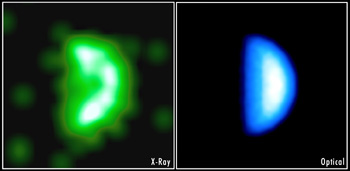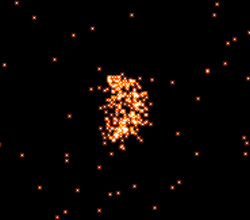November 29, 2001
NASA PR: 01-236
Scientists have captured the first X-ray view of Venus using NASA's Chandra X-ray Observatory. The observations provide new information about the atmosphere of Venus and open a new window for examining Earth's sister planet.
Venus in X-rays looks similar to Venus in visible light, but there are important differences. The optically visible Venus is due to the reflection of sunlight and, for the relative positions of Venus, Earth and Sun during these observations, shows a uniform half-crescent that is brightest toward the middle. The X-ray Venus is slightly less than a half-crescent and brighter on the limbs.
The differences are due to the processes by which Venus shines in visible and X-ray light. The X-rays from Venus are produced by fluorescence, rather than reflection. Solar X-rays bombard the atmosphere of Venus, knock electrons out of the inner parts of the atoms, and excite the atoms to a higher energy level. The atoms almost immediately return to their lower energy state with the emission of a fluorescent X-ray. A similar process involving ultraviolet light produces the visible light from fluorescent lamps.
For Venus, most of the fluorescent X-rays come from oxygen and carbon atoms between 120 and 140 kilometers (74 to 87 miles) above the planet's surface. In contrast, the optical light is reflected from clouds at a height of 50 to 70 kilometers (31 to 43 miles). As a result, Venus' Sun-lit hemisphere appears surrounded by an almost-transparent luminous shell in X-rays. Venus looks brightest at the limb since more luminous material is there.

X-ray/Optical Composite of Venus
Credit: Xray: NASA/CXC/MPE/K.Dennerl et al., Optical: Konrad Dennerl
"This opens up the exciting possibility of using X-ray observations to study regions of the atmosphere of Venus that are difficult to investigate by other means," said Konrad Dennerl of the Max Planck Institute for Extraterrestrial Physics in Garching, Germany, leader of an international team of scientists that conducted the research.
The Chandra observation of Venus was also a technological tour de force. The angular separation of Venus from the Sun, as seen from Earth, never exceeds 48 degrees. This relative proximity has prevented star trackers and cameras on other X-ray astronomy satellites from locking onto guide stars and pointing steadily in the direction of Venus to perform such an observation.
Venus was observed on Jan. 10, 2001, with the Advanced CCD Imaging Spectrometer (ACIS) detector plus the Low Energy Transmission Grating and on Jan. 13, 2001, with the ACIS alone. Other members of the team were Vadim Burwitz and Jakob Engelhauser, Max Planck Institute; Carey Lisse, University of Maryland, College Park; and Scott Wolk, Harvard-Smithsonian Center for Astrophysics, Cambridge, Mass. These results were presented at this week's "New Visions of X-ray universe in the XMM-Newton and Chandra Era" symposium in Noordwijk, Netherlands.
The Low Energy Transmission Grating was built by the Space Research Organization of the Netherlands and the Max Planck Institute, and the ACIS instrument was developed for NASA by The Pennsylvania State University, University Park, and the Massachusetts Institute of Technology (MIT), Cambridge. NASA's Marshall Space Flight Center in Huntsville, Ala., manages the Chandra program. The Smithsonian's Chandra X-ray Center controls science and flight operations from Cambridge, Mass.
MEDIA CONTACTS
Dolores Beasley
Headquarters, Washington
Phone: 202/358-1753
Steve Roy
Marshall Space Flight Center, Huntsville, AL
Phone: 256-544-6535
Megan Watzke
Chandra X-ray Observatory Center, CfA, Cambridge, MA
Phone: 617-496-7998



